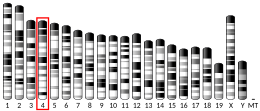From Wikipedia, the free encyclopedia
Protein-coding gene in the species Homo sapiens
Bartter syndrome, infantile, with sensorineural deafness (Barttin) , also known as BSND , is a human gene which is associated with Bartter syndrome .[ 5]
This gene encodes an essential beta subunit for CLC chloride channels . These heteromeric channels localize to basolateral membranes of renal tubules and of potassium-secreting epithelia of the inner ear . Mutations in this gene have been associated with Bartter syndrome with sensorineural deafness .[ 5]
Birkenhäger R, Otto E, Schürmann MJ, et al. (2001). "Mutation of BSND causes Bartter syndrome with sensorineural deafness and kidney failure". Nat. Genet . 29 (3): 310– 4. doi :10.1038/ng752 . PMID 11687798 . S2CID 5892001 . Estévez R, Boettger T, Stein V, et al. (2001). "Barttin is a Cl− channel beta-subunit crucial for renal Cl− reabsorption and inner ear K+ secretion". Nature . 414 (6863): 558– 61. Bibcode :2001Natur.414..558E . doi :10.1038/35107099 . PMID 11734858 . S2CID 4407807 . Waldegger S, Jeck N, Barth P, et al. (2003). "Barttin increases surface expression and changes current properties of ClC-K channels". Pflügers Arch . 444 (3): 411– 8. doi :10.1007/s00424-002-0819-8 . PMID 12111250 . S2CID 8546107 . Strausberg RL, Feingold EA, Grouse LH, et al. (2003). "Generation and initial analysis of more than 15,000 full-length human and mouse cDNA sequences" . Proc. Natl. Acad. Sci. U.S.A . 99 (26): 16899– 903. Bibcode :2002PNAS...9916899M . doi :10.1073/pnas.242603899 PMC 139241 PMID 12477932 . Miyamura N, Matsumoto K, Taguchi T, et al. (2003). "Atypical Bartter syndrome with sensorineural deafness with G47R mutation of the beta-subunit for ClC-Ka and ClC-Kb chloride channels, barttin". J. Clin. Endocrinol. Metab . 88 (2): 781– 6. doi :10.1210/jc.2002-021398 . PMID 12574213 . S2CID 28041186 . Hayama A, Rai T, Sasaki S, Uchida S (2004). "Molecular mechanisms of Bartter syndrome caused by mutations in the BSND gene". Histochem. Cell Biol . 119 (6): 485– 93. doi :10.1007/s00418-003-0535-2 . PMID 12761627 . S2CID 24080298 . Gerhard DS, Wagner L, Feingold EA, et al. (2004). "The status, quality, and expansion of the NIH full-length cDNA project: the Mammalian Gene Collection (MGC)" . Genome Res . 14 (10B): 2121– 7. doi :10.1101/gr.2596504 . PMC 528928 PMID 15489334 . Embark HM, Böhmer C, Palmada M, et al. (2005). "Regulation of CLC-Ka/barttin by the ubiquitin ligase Nedd4-2 and the serum- and glucocorticoid-dependent kinases" . Kidney Int . 66 (5): 1918– 25. doi :10.1111/j.1523-1755.2004.00966.x PMID 15496163 . García-Nieto V, Flores C, Luis-Yanes MI, et al. (2006). "Mutation G47R in the BSND gene causes Bartter syndrome with deafness in two Spanish families". Pediatr. Nephrol . 21 (5): 643– 8. doi :10.1007/s00467-006-0062-1 . PMID 16572343 . S2CID 24786634 . Ozlu F, Yapicioğlu H, Satar M, et al. (2006). "Barttin mutations in antenatal Bartter syndrome with sensorineural deafness" . Pediatr. Nephrol . 21 (7): 1056– 7. doi :10.1007/s00467-006-0108-4 . PMID 16773427 . S2CID 13158377 . Scholl U, Hebeisen S, Janssen AG, et al. (2006). "Barttin modulates trafficking and function of ClC-K channels" . Proc. Natl. Acad. Sci. U.S.A . 103 (30): 11411– 6. Bibcode :2006PNAS..10311411S . doi :10.1073/pnas.0601631103 PMC 1544099 PMID 16849430 .



